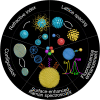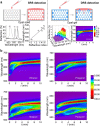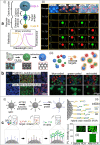Bottom-Up Assembled Photonic Crystals for Structure-Enabled Label-Free Sensing
- PMID: 34028246
- PMCID: PMC8291770
- DOI: 10.1021/acsnano.1c02495
Bottom-Up Assembled Photonic Crystals for Structure-Enabled Label-Free Sensing
Abstract
Photonic crystals (PhCs) display photonic stop bands (PSBs) and at the edges of these PSBs transport light with reduced velocity, enabling the PhCs to confine and manipulate incident light with enhanced light-matter interaction. Intense research has been devoted to leveraging the optical properties of PhCs for the development of optical sensors for bioassays, diagnosis, and environmental monitoring. These applications have furthermore benefited from the inherently large surface area of PhCs, giving rise to high analyte adsorption and the wide range of options for structural variations of the PhCs leading to enhanced light-matter interaction. Here, we focus on bottom-up assembled PhCs and review the significant advances that have been made in their use as label-free sensors. We describe their potential for point-of-care devices and in the review include their structural design, constituent materials, fabrication strategy, and sensing working principles. We thereby classify them according to five sensing principles: sensing of refractive index variations, sensing by lattice spacing variations, enhanced fluorescence spectroscopy, surface-enhanced Raman spectroscopy, and configuration transitions.
Keywords: limit of detection; optical label-free sensor; photonic crystals; photonic stop band; self-assembly; sensitivity; signal readout; slow light.
Conflict of interest statement
The authors declare no competing financial interest.
Figures
















Similar articles
-
Spherical colloidal photonic crystals.Acc Chem Res. 2014 Dec 16;47(12):3632-42. doi: 10.1021/ar500317s. Epub 2014 Nov 13. Acc Chem Res. 2014. PMID: 25393430
-
Metasurface Micro/Nano-Optical Sensors: Principles and Applications.ACS Nano. 2022 Aug 23;16(8):11598-11618. doi: 10.1021/acsnano.2c03310. Epub 2022 Aug 12. ACS Nano. 2022. PMID: 35960685 Review.
-
From colloidal particles to photonic crystals: advances in self-assembly and their emerging applications.Chem Soc Rev. 2021 May 24;50(10):5898-5951. doi: 10.1039/d0cs00706d. Chem Soc Rev. 2021. PMID: 34027954 Review.
-
Near-Infrared Silicon Photonic Crystals with High-Order Photonic Bandgaps for High-Sensitivity Chemical Analysis of Water-Ethanol Mixtures.ACS Sens. 2018 Nov 26;3(11):2223-2231. doi: 10.1021/acssensors.8b00933. Epub 2018 Nov 7. ACS Sens. 2018. PMID: 30380852
-
Photonic crystals for chemical sensing and biosensing.Angew Chem Int Ed Engl. 2014 Mar 24;53(13):3318-35. doi: 10.1002/anie.201307828. Epub 2014 Jan 28. Angew Chem Int Ed Engl. 2014. PMID: 24473976 Review.
Cited by
-
Swarming Responsive Photonic Nanorobots for Motile-Targeting Microenvironmental Mapping and Mapping-Guided Photothermal Treatment.Nanomicro Lett. 2023 May 29;15(1):141. doi: 10.1007/s40820-023-01095-5. Nanomicro Lett. 2023. PMID: 37247162 Free PMC article.
-
Stray Light in 3D Porous Nanostructures of Single-Crystalline Copper Film.Small Sci. 2024 Aug 2;4(11):2400174. doi: 10.1002/smsc.202400174. eCollection 2024 Nov. Small Sci. 2024. PMID: 40213452 Free PMC article.
-
Miniaturized, high numerical aperture confocal fluorescence detection enhanced with pyroelectric droplet accumulation for sub-attomole analyte diagnosis.Biomed Opt Express. 2023 Nov 3;14(12):6138-6150. doi: 10.1364/BOE.504757. eCollection 2023 Dec 1. Biomed Opt Express. 2023. PMID: 38420309 Free PMC article.
-
Navigating the Landscape of Dry Assembling Ordered Particle Structures: Can Solvents Become Obsolete?Small. 2024 Dec;20(49):e2405410. doi: 10.1002/smll.202405410. Epub 2024 Sep 16. Small. 2024. PMID: 39282807 Free PMC article. Review.
-
Hybridization of surface plasmons and photonic crystal resonators for high-sensitivity and high-resolution sensing applications.Sci Rep. 2022 Dec 9;12(1):21292. doi: 10.1038/s41598-022-25980-y. Sci Rep. 2022. PMID: 36494440 Free PMC article.
References
-
- Wang J.; Le-The H.; Shui L.; Bomer J. G.; Jin M.; Zhou G.; Mulvaney P.; Pinkse P. W. H.; van den Berg A.; Segerink L. I.; Eijkel J. C. T. Multilevel Spherical Photonic Crystals with Controllable Structures and Structure-Enhanced Functionalities. Adv. Opt. Mater. 2020, 8, 1902164.10.1002/adom.201902164. - DOI
Publication types
MeSH terms
LinkOut - more resources
Full Text Sources
Other Literature Sources

